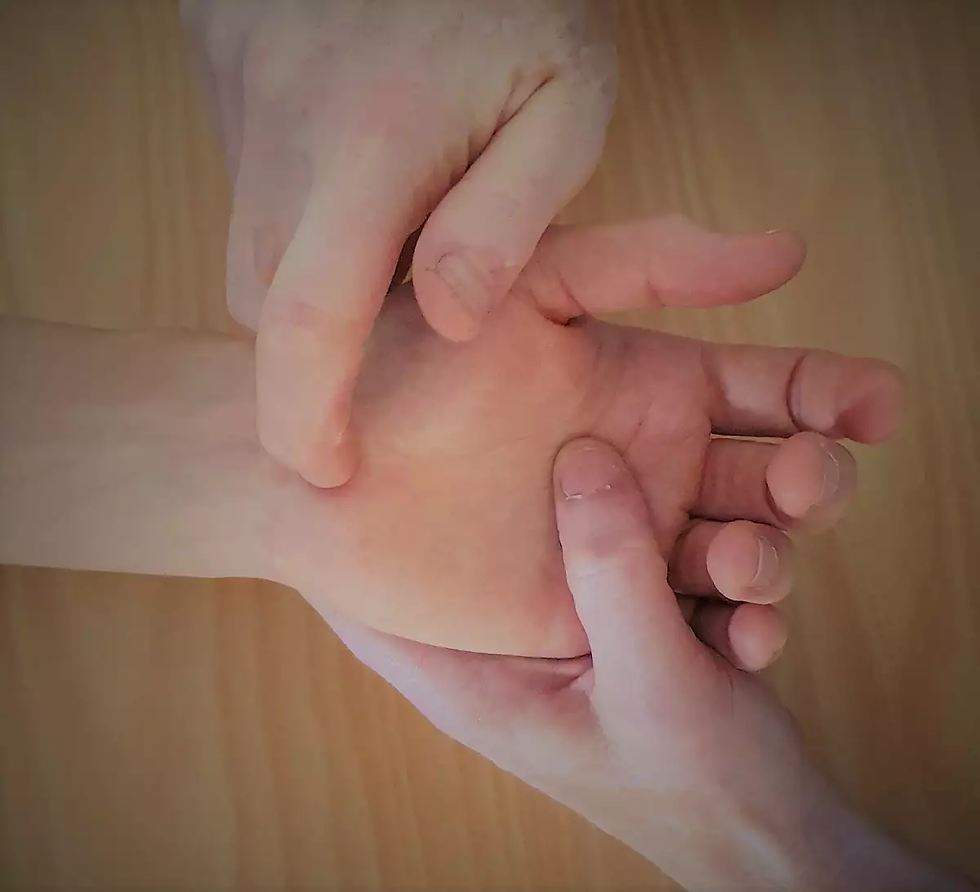Tinels Test
- Fysiobasen

- Sep 14
- 3 min read
Tinel’s sign is a simple yet clinically valuable test used to identify compression neuropathies in peripheral nerves. A positive finding produces a tingling or “pins and needles” sensation distal to the percussion site, which may indicate either ongoing nerve regeneration or pressure-related nerve injury¹.
The advantages of the test are that it is quick, requires no equipment, and can be applied at multiple anatomical locations. Limitations are mainly related to its variable sensitivity and the fact that it should never be used in isolation for diagnosis².

Historical Background
Tinel’s sign, originally known as the Hoffmann-Tinel sign, was first described during World War I by French and German neurologists Jules Tinel and Paul Hoffmann. They observed that percussion of an injured nerve elicited distal paresthesia in its sensory distribution – interpreted as a sign of regeneration or irritation of nerve fibers².
Clinical Anatomy and Neurophysiology
Peripheral nerve injuries often develop increased electrical sensitivity around the lesion site during regeneration. This is due to ectopic firing – spontaneous discharges from unstable ion channels in regrowing axons. Percussion of this area provokes a sensory response in the nerve’s distal innervation zone³.
This mechanism makes Tinel’s sign useful in both acute compression neuropathies and during nerve regeneration.
Test Procedure
Steps:
Localize the nerve to be tested (e.g., median nerve at the carpal tunnel, ulnar nerve at the elbow, tibial nerve in the tarsal tunnel).
Percuss lightly over the nerve using fingers or a reflex hammer.
Ask the patient whether tingling, stinging, or “electric shock” sensations are felt distally along the nerve distribution.
Positive finding:
Patient reports distal paresthesia following the nerve’s distribution (e.g., thumb, index, and middle finger in median nerve compression).
Clinical Applications
Tinel’s sign is used in suspected cases of⁴:
Carpal tunnel syndrome (median nerve)
Cubital tunnel syndrome (ulnar nerve)
Guyon’s canal syndrome (ulnar nerve at wrist)
Tarsal tunnel syndrome (tibial nerve)
Radial nerve entrapment
Superficial peroneal nerve neuropathy
Thoracic outlet syndrome
It has also been observed in diabetic neuropathy, though with lower specificity⁹.
Evidence and Diagnostic Value
The diagnostic accuracy varies by location and condition:
Meta-analyses confirm that Tinel’s sign generally shows low sensitivity but high specificity, particularly in carpal tunnel syndrome⁶.
Median sensitivity: 0.45–0.51
Specificity: 0.78–0.90⁵⁻⁶
This means a positive test is useful for confirming a diagnosis, but a negative test cannot rule it out.
Clinical Considerations
Quick and easy to perform, useful in screening.
A positive Tinel’s may reflect nerve regeneration potential after trauma or surgery.
Always interpret in combination with other neurological tests (e.g., Phalen’s test, Froment’s sign) and case history.
More difficult to interpret in obese patients or those with significant soft tissue.
Summary
Tinel’s sign remains an important clinical tool for evaluating compression neuropathies and peripheral nerve injuries. While its sensitivity is variable, its high specificity makes it especially valuable for confirming conditions such as carpal tunnel and cubital tunnel syndrome. Best practice is to use it in combination with other clinical tests and diagnostic imaging.
Source:
Davis EN, Chung KC. The Tinel sign: a historical perspective. Plastic and Reconstructive Surgery. 2004 Aug 1;114(2):494–499.
Ho T, ME B. Hoffmann Tinel Sign. [Updated 2021 Nov 21]. StatPearls. Treasure Island (FL): StatPearls Publishing; 2022.
Tinel J, Kaplan EB. The “tingling” sign in peripheral nerve lesions. Injuries to the Major Branches of Peripheral Nerves of the Forearm. 1978:8.
Moldaver JO. Tinel's sign. Its characteristics and significance. J Bone Joint Surg Am. 1978 Apr 1;60(3):412–414.
Ozdag Y, Hu Y, Hayes DS, Manzar S, Akoon A, Klena JC, Grandizio LC. Sensitivity and specificity of examination maneuvers for carpal tunnel syndrome: a meta-analysis. Cureus. 2023 Jul;15(7).
Dabbagh A, MacDermid JC, Yong J, Packham TL, Grewal R, Boutsikari EC. Diagnostic test accuracy of provocative maneuvers for the diagnosis of carpal tunnel syndrome: a systematic review and meta-analysis. Physical Therapy. 2023 Jun 1;103(6):pzad029.
TINEL’S SI. Tinel’s sign and Phalen’s maneuver: physical signs of carpal tunnel syndrome. Hospital Physician. 2000 Jul:39.
Pandey T, Slaughter AJ, Reynolds KA, Jambhekar K, David RM, Hasan SA. Clinical orthopedic examination findings in the upper extremity: correlation with imaging studies and diagnostic efficacy. Radiographics. 2014 Mar;34(2):e24–40.
Lee CH, Dellon AL. Prognostic ability of Tinel sign in determining outcome for decompression surgery in diabetic and nondiabetic neuropathy. Annals of Plastic Surgery. 2004 Dec 1;53(6):523–527.









